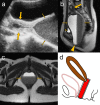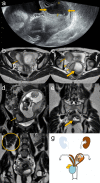Congenital anomalies causing hemato/hydrocolpos: imaging findings, treatments, and outcomes
- PMID: 33840015
- PMCID: PMC8338850
- DOI: 10.1007/s11604-021-01115-7
Congenital anomalies causing hemato/hydrocolpos: imaging findings, treatments, and outcomes
Abstract
Hemato/hydrocolpos due to congenital urogenital anomalies are rare conditions discovered in neonatal, infant, and adolescent girls. Diagnosis is often missed or delayed owing to its rare incidence and nonspecific symptoms. If early correct diagnosis and treatment cannot be performed, late complications such as tubal adhesion, pelvic endometriosis, and infertility may develop. Congenital urogenital anomalies causing hemato/hydrocolpos are mainly of four types: imperforate hymen, distal vaginal agenesis, transverse vaginal septum, and obstructed hemivagina and ipsilateral renal anomaly, and clinicians should have adequate knowledge about these anomalies. This article aimed to review the diagnosis and treatment of these urogenital anomalies by describing embryology, clinical presentation, imaging findings, surgical management, and postoperative outcomes.
Keywords: Distal vaginal agenesis; Hematocolpos; Imperforate hymen; OHVIRA; Transverse vaginal septum.
© 2021. The Author(s).
Conflict of interest statement
The authors declare that there is no conflict of interest.
Figures







References
Publication types
MeSH terms
LinkOut - more resources
Full Text Sources
Other Literature Sources

